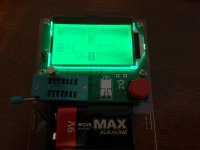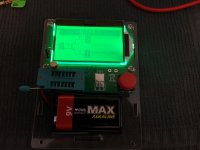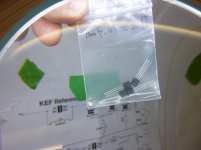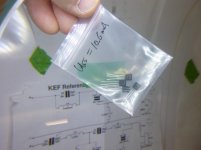Just buy them from B & D Enterprises while they have them in stock. They are Authorized Distributor for Japanese transistor makes like Toshiba, SanKen, FUJI Electric, Shindengen, etc.
Thanks, have found them (I think) and sent off an email enquiry.
Andy
It seems that the reserve of NOS Toshiba jfets has been completely exhausted. Your only hope now is pulled parts.A few years ago, I bought some 2SJ74GR.....
Fake semiconductors are routinely sold on eBay. So fake that even a Chinese tester can be used to detect an "outside the datasheet" issue like here, gate leakage current (~10nA).
So not sure about these parts. Perhaps the other tests should be done? Or is the cheap China tester just that - a cheap China tester?
Following up on the cheap tester question. I have a few low Idss LSK389A purchased from NAC Semi I just tried to measure with the tester. (Using the low Idss because it will be used with higher Vds without cascode and wanted to keep the lower noise figure - datasheet for LSK389 states noise figure is at 2mA).
So here is a very genuine low Idss NJFET on the cheap tester. Perhaps it is the low Vgs that gives the tester difficulty. Wouldn't go by the tester alone, although it is a helpful device for quick tests, it is not very accurate.
Attachments
So here is a very genuine low Idss NJFET on the cheap tester. Perhaps it is the low Vgs that gives the tester difficulty. Wouldn't go by the tester alone, although it is a helpful device for quick tests, it is not very accurate.
I don't understand the continued mis-understanding here you CAN'T test and N channel JFET as an NPN transistor. What is not clear about this??????
I was trying to show that these cheap testers were inaccurate so that others don"t use them for checking. Is that clear enough now?I don't understand the continued mis-understanding here you CAN'T test and N channel JFET as an NPN transistor. What is not clear about this??????
The tester determines the part type. I am not testing a JFET using an NPN test. If you are unfamiliar with these testers you are making things unclear.
Last edited:
The tester determines the part type.
Yes, the wrong one.
I am not testing a JFET using an NPN test.
Yes you are.
It's obvious what the tester is doing, I'll leave you to figure it out.
Yes you are.
It's obvious what the tester is doing, I'll leave you to figure it out.
Here's an LSK489 mounted the very same way in the same tester. Much higher Vgs.
I was trying to be helpful, not critical. If you had explained how the other person and myself testing JFETs with these testers are 'testing wrong' so to speak, well it would be very helpful. Not sure why being critical instead of helpful is the point of some of these posts. Whatever.
Attachments
Following up on the cheap tester question. I have a few low Idss LSK389A purchased from NAC Semi I just tried to measure with the tester. (Using the low Idss because it will be used with higher Vds without cascode and wanted to keep the lower noise figure - datasheet for LSK389 states noise figure is at 2mA).
So here is a very genuine low Idss NJFET on the cheap tester. Perhaps it is the low Vgs that gives the tester difficulty. Wouldn't go by the tester alone, although it is a helpful device for quick tests, it is not very accurate.
I always double check a device supposed to be a jfet on Idss because it's well specified in the datasheet. Re the 2SK170's (class "BL") I received, their Idss was at the lower end of the "GR" class which already is enough for the label "fake" - no need to measure gate leakage current. My impression is that the Chinese sellers know very well what they're selling. I received 2SK30A, 2SK373 and these jfets behave according to specifications (datasheet). I also received bipolars, 2SA970 "BL" and 2SC2240 "BL" but with hFE at the lower end of the "GR" class. Immediate refund (with apologies) after reporting that, no further questions asked.
I don't doubt that there are fake parts all over the place out there. Was just trying to find out why the LCR-T4 tester was giving different results.
...Apparently my testing error is quite obvious. If anyone could point out what the obvious testing error is it would go a long way in making the criticism constructive.
...Apparently my testing error is quite obvious. If anyone could point out what the obvious testing error is it would go a long way in making the criticism constructive.
I don't understand the continued mis-understanding here you CAN'T test and N channel JFET as an NPN transistor.
It's well known that these little totally automated testers do OK for 99% of parts, but sometimes go down the wrong path.
The tester does what you would do with unknown part and orientation: poke some juice at it and try to interpret it as some class of device, then measure like it was that class.
No, the user can't give the tester a clue.
These things were written by Programmers. Any transistor-man would know that hFE=99K is bogus, even 2K is dubious; but the programmers didn't know this.
I went into the notes and code once, it's all open-source. But too complicated for me. The algorithms and decision-points have been changed over the years, they are better. Maybe the one he has uses an older code; maybe so few people use high-Gm JFETs that this screw-up has not bubbled to the top of the bug-list.
IAC it is trivial to rig a battery and two meters (one is less convenient) and measure JFETs the right way.
Yes, that is more than a bit harsh.
I too purchased a cheap $20.00 transistor tester it also incorrectly identified a bag of JFETs as NPN transistors.
The cheap $20.00 transistor tester was intended to do a quick screening. In this case it did not work out so well.
Thanks DT
I too purchased a cheap $20.00 transistor tester it also incorrectly identified a bag of JFETs as NPN transistors.
The cheap $20.00 transistor tester was intended to do a quick screening. In this case it did not work out so well.
Thanks DT
I too have that cheap tester, and I find it very useful. It never happened to me that it would identify jfet as npn transistor.
I use this guidelines (Fig 9) to construct curves to match jfets:
Biasing JFETS
The tester has limitations, but for quick Idss selections its ok. Plus it measures caps, resistor, diods, you name it. Not bad for $20.
I use this guidelines (Fig 9) to construct curves to match jfets:
Biasing JFETS
The tester has limitations, but for quick Idss selections its ok. Plus it measures caps, resistor, diods, you name it. Not bad for $20.
It's more like $10 shipped: for that price, no complain, but it doesn't do FETs; for these, I use EUVL's jig. Next, I'll add Vp as per PMA.
I love the convenience of the Mega328 tester.
Mine has also mistakenly auto detected JFET's as bipolar transistors.
They are terrific considering the cost, but some user intuition is still required. It has never gotten an EBC pinout wrong on a bipolar device, and when it detects a JFET, it gets that right also.
Mine has also mistakenly auto detected JFET's as bipolar transistors.
They are terrific considering the cost, but some user intuition is still required. It has never gotten an EBC pinout wrong on a bipolar device, and when it detects a JFET, it gets that right also.
Seeing how many of the diy circuits measure values at certain steps only gets me thinking... maybe it would be nice to have an Arduino based curve tracer. Could always start with a simple breakout/hat, and can be written in C.
Matlab simulink has lots of interesting features. Last semester there was a guy in one of my project classes using Matlab Simulink and an Arduino DUE as as DAQ for a marine thruster. The sample rate is low but seems like there is potential for much more analysis once the data is in Matlab.
That said the cheap tester is convenient for identifying most parts plug it in push the button. Beyond that it seems like there might be room for another solution once the device type and pinout are known and one is trying to find the device parameters.
C code easily generates a Matlab best fit line graph, it was one of my lab homework problems last semester. Maybe I'll break down and get an arduino after all. And try to figure out to make the code generate excel best fit line.
Matlab simulink has lots of interesting features. Last semester there was a guy in one of my project classes using Matlab Simulink and an Arduino DUE as as DAQ for a marine thruster. The sample rate is low but seems like there is potential for much more analysis once the data is in Matlab.
That said the cheap tester is convenient for identifying most parts plug it in push the button. Beyond that it seems like there might be room for another solution once the device type and pinout are known and one is trying to find the device parameters.
C code easily generates a Matlab best fit line graph, it was one of my lab homework problems last semester. Maybe I'll break down and get an arduino after all. And try to figure out to make the code generate excel best fit line.

- Home
- Design & Build
- Parts
- How to identify fake JFETs?



